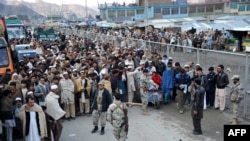For the past decade, Saleem Jan Shinwari has been importing dried fruits from Afghanistan to various towns in his native Khyber Pakhtunkhwa province. War and strained diplomatic relations between Kabul and Islamabad expose cross-border traders like Shinwari to harassment by customs officials at Torkham, the busy border crossing in the Khyber Pass.
"When the relations between both countries become worse, my business becomes more difficult," he says.
For the entrepreneurs who brave high tariffs, poor road conditions, and rogue customs officials to transport their goods across the Durand Line, the Pakistan-Afghanistan Joint Chamber of Commerce (PAJCCI) provides a lone channel through which to air their grievances to government officials in both countries.
Founded in 2012 on the back of a $1.1 million European Union initiative, the association is a grassroots expansion of initiatives by both Kabul and Islamabad to improve economic relations. Three years on, the association boasts 300 Pakistani and 100 Afghan members, but continuing infrastructural and bureaucratic obstacles highlight that the chamber has yet to fulfill its role of encouraging peace and economic openness.
The PAJCCI's founding followed the 2010 Afghanistan-Pakistan Transit Trade Agreement (APTTA), which granted special privileges to Afghan truck drivers transporting goods to major Pakistani cities. Following this agreement, the trade volume between the two countries increased from $1.9 billion in 2009 to $2.5 billion at the end of 2011.
But goodwill by both governments has since diminished. Afghanistan’s 2012 decision to triple import tariffs raised the rate of illegal smuggling, and drivers transporting Afghan goods through Pakistan experienced harassment by police officials. In the past three years, the official trade volume between Afghanistan and Pakistan has plummeted to $830 million.
Still, the chamber’s founders say increased cooperation can open up new trade vistas for the two countries. If Afghanistan allows it, Pakistan can gain access to Central Asian states, says former PAJCCI chairman Zahid Ullah Shinwari, who heads the Chamber of Commerce and Industry in Khyber Pakhtunkhwa.
Shinwari suggested that Pakistan improve its image across the border by supporting Afghan traders and investing in mutually beneficial infrastructural projects. He also urged the Pakistan government to crack down on police who harass Afghan traders, facilitate the issuance of visas on arrival, and promote medical tourism by Afghan citizens. If the Afghan and Pakistani governments address the existing hurdles, bilateral trade volume could increase to $5 billion by 2017, he added.
New Members, Old Barriers
In an interview with Afghanistan Today, PAJCCI co-founder M. Zubair Motiwala, who shares chairmanship of the organization with his Afghan counterpart on an annually rotating basis, said the chamber’s main objectives are to resolve trade-based issues between both countries and improve relations between the two governments.
For an annual fee of 10,500 Pakistani rupees, PAJCCI members like Saleem Shinwari can report obstacles to cross-border trade to relevant government bodies. The association also organizes cross-border seminars and meetings between traders and government authorities.
"I have no contacts in the ministries of commerce in Pakistan or Afghanistan, but when I face a problem I can easily contact the PAJCCI," said Shinwari, who joined PAJCCI last year.
On the road from the Torkham crossing to Peshawar, Pakistan security officials subject Afghan drivers to frequent searches and regularly demand bribes even if traders have proper documentation, says Maqsood Jan, an Afghan nut dealer who regularly travels to Peshawar to meet with his Pakistani business partners.
Jan is one of the PAJCCI’s newest members. There are signs that both countries want to boost economic ties, he says, but lack the support of their governments to do so.
"On both sides of the border, this kind of association can help resolve the problem of traders,” he adds. "If we unite, our voices will be strengthened."






